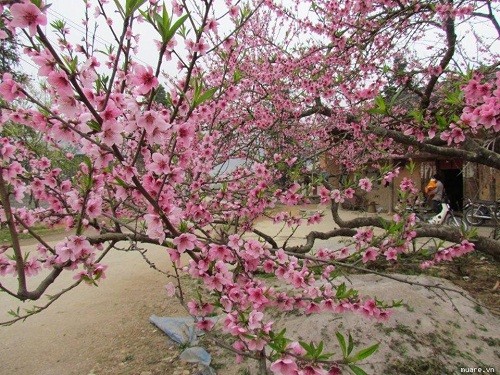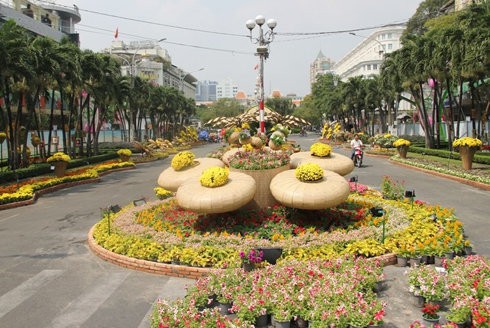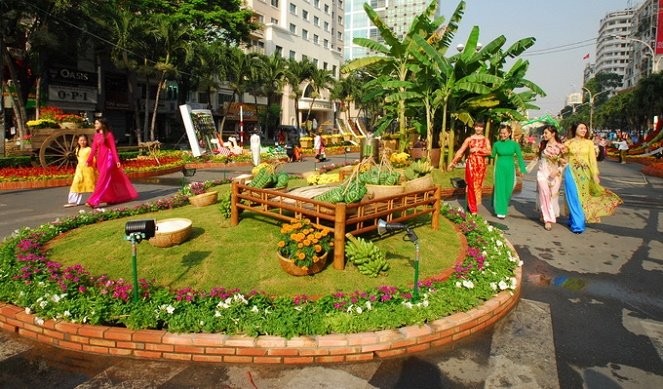(VOVworld) – Whenever Tet, Vietnam’s Lunar New Year holiday, comes, all happily welcome spring, a time of rebirth and renewal, with customs immemorial. Activities like shopping for Tet flowers, taking the first spring walk on New Year’s Eve, and sending Tet greetings has enriched the cultural life of the Vietnamese nation. Despite the changes of today’s society, the meaning of Tet remains the same. Today we’ll take a look at how people in Vietnam’s two main regions celebrate the Tet festival.
 |
| Peach Flower - the must-have element of North Vietnam Tet |
In recent years, whenever Tet, Vietnam’s Lunar New Year holiday, approaches, flowers and bonsais of various types and colors, domestically-grown or imported, are transported to Hanoi. For Hanoians, peach flowers are the preferred flower for the occasion.
Nguyen Duc Binh, a resident of the capital city, says: “peach flowers represent spring. As a custom, a Vietnamese family, rich or poor, wants to bring a branch of peach blossoms into the house. That means spring has arrived in your house.”
Hanoi residents have a reputation for being fussy when it comes to selecting flowers and bonsais. This year many prefer a special ornamental plant grown by Le Duc Giap, a farmer in the outlying district of Thanh Oai.

In addition to five-fruit trees, which were offered for the first time during Lunar New Year 2014, this year Giap has prepared seven- and nine-fruit trees. (Photo: vietnamnet.vn)
|
The 62-year-old farmer is the first Vietnamese who has successfully grafted 9 kinds of fruit onto the same tree. The 9 fruits include grapefruit, orange, Buddha-hand fruit, tangerine, and lemon.
With a total area of 7,000m2, the garden has more than 200 trees, all of them reserved by customers long before Tet.
Giap says the trees are only available for Tet because “nine is a lucky number. The 9-fruit tree looks colorful and represents luck and prosperity. The symbolism of a tree with nine fruits is a family gathering.”
If the northern city of Hanoi is covered with peach flowers in the spring, it is apricot blossoms which cover Ho Chi Minh City in the south. To meet the local demand, thousands of apricot trees are relocated from Vietnam’s central provinces. Huynh Van Minh who lives in Ho Chi Minh City’s District 1 says: “it wouldn’t be a real Tet without apricot blossoms. In the past, it was the sound and smell of firecrackers that invoked the Tet atmosphere, but now it’s the yellow color of apricot blossom that signals Tet has come.”
Street festivals, Tet flower displays, and streets festooned with beautiful Tet decorations attract crowds of people to Vietnam’s two main cities to welcome New Year’s Eve.
 |
| The 2015 Tet Flower Street in Ho Chi Minh City is relocated in Ham Nghi |
Although there is no designated flower street in Hanoi this year, carpets of flowers have been laid along key downtown streets. Lights decorate the area around Sword Lake, the statue of Ly Thai To, Ba Dinh Square, and other public places. Nhat Tan Bridge across the Red River, the biggest and most beautiful cable-stayed bridge in Asia, lights up at night to make Hanoi even more beautiful.
 |
| This year’s iconic Tet flower street is themed ‘Vietnamese Identity-Vietnamese Spirit’ |
In Ho Chi Minh City, Ham Nghi Street is the iconic Tet flower street, taking as its theme this year ‘Vietnamese Identity-Vietnamese Spirit’.
Tran Bien of Ho Chi Minh City has this to say: “the staff of tour operator Saigontourist and artisans with deft hands have created beautiful roads of flowers and inspired local residents and visitors to come admire them during the Tet holiday.”
On New Year’s Eve, families in Ho Chi Minh City like to walk around downtown until midnight approaches and then rush to one of several firework display areas to ring in the New Year together.
In Hanoi, the cold persuades many people to gather at home to exchange greetings of good luck and good health when the first fireworks shoot into the sky.